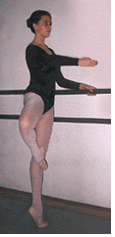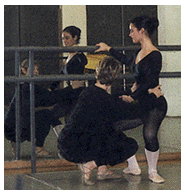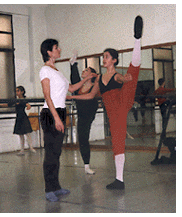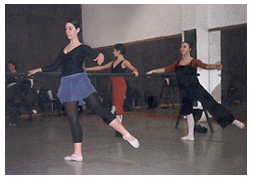...Best of Sicily
presents... Best of Sicily Magazine. ... Dedicated to Sicilian art, culture, history, people, places and all things Sicilian. |
by André Mantegna | ||
Magazine Index Best of Sicily Arts & Culture Fashion Food & Wine History & Society About Us Travel Faqs Contact Map of Sicily |
While the popularity of ballet in Sicily has never been in doubt, the opera houses of Catania and Palermo lack resident ballet companies, a fact which often forces Sicily's best talent to seek a home abroad. That was the case for Eleonora Abbagnato. She studied with Marisa Benassai until moving to Paris to continue her rigorous training, finding a place in the Paris Opera Ballet. Nobody is born a prima ballerina, and nobody knows that better than the dancers themselves. It takes effort and patience. And time in corps de ballet, supporting parts that build character and develop skills to perfection before dancing solo. An exceptionally talented girl might start dancing around the age of eight, but could begin studying ballet as late as twelve and still reach the professional level by eighteen. Ballet's grace and discipline can benefit the poise, posture, presence
and physical fitness of any girl, even if she doesn't aspire to perform
in one of the world's great dance companies. In that sense, ballet is not
unlike gymnastics, figure skating or certain martial arts, where precision,
flexibility and strength are essential. The private ballet schools are a precious resource. Almost a subculture, the instructors form a loose network of remarkably dedicated and exceptionally accomplished professional dancers, most now retired from performing, whose mastery and knowledge of their art makes them exceptional. In Europe, ballet enjoys a special place as the traditional athletic pursuit of active girls, and its pre-eminence seems unchallenged in Italy, where this artform originated. What you see on stage during a performance is just a tiny part of all
that is ballet --the tip of the iceberg. Nobody becomes a good dancer without
a good teacher. One of them is Melissa Mackie, Cornish by birth, who has
lived and taught in Sicily for almost fifteen years. At around five feet,
six inches, she is tall for a ballerina. A glance at her figure leaves no
doubt that, height aside, she was born to be a dancer. At fifteen, Melissa
was accepted into London's Royal Ballet School. She was shorter then. Genetics
can be unpredictable, and Melissa's adult height became a handicap in her
audition for the Royal Ballet as a professional dancer. She was simply too
tall. But that didn't prevent her from earning a teaching diploma Coming from a classical background, Ms. Mackie has definite ideas about foundation training, but she is pragmatic enough to know that each student's needs are unique. What works well for one girl may not work quite so well for another, even when the goal is the same. Physical education programs in most Italian schools leave a little to be desired, especially for girls, but the experience of "single gender" classes, often cited as an important element in the formation of a young woman's self-confidence, is a facet of ballet that cannot be overlooked. Boys study ballet, too, but in Italy the vast majority of students are girls. Ballet's learning environment is austere. No stage lamps, no floodlights,
no curtain. No audience. Just a large room, a practice bar and a mirror.
To enter such a setting is Marisa Benassai and Melissa Mackie have become veritable institutions in Sicily, and they're not alone. It's clear that dance talent is not lacking in Italy's largest region. And local audiences are enthusiastic. Classical ballet's day-to-day challenges, if not highly visible to outsiders, are part of a long road. Along the way, the girl becomes a woman. A true individual. About the Author: André Mantegna writes about entertainment and fashion related topics for several magazines published in Italy and the United Kingdom. This article was written exclusively for publication by Best of Sicily. | |
Top of Page |
 It's the place where athletic grace becomes high art. It's a question of finding
physical and mental limits, and then surpassing them. Ballet is almost a
way of life. A philosophy. Hardly anything else comes close. And then there's
the ballerina. A tough cookie masked by a delicate exterior. Unintimidated
by long hours of demanding concentration, physical endeavor, sore muscles,
precise movements and plain, old-fashioned hard work. And a strict diet.
And pain. Dedication alone separates her from her sisters. But if ballet
were just about being different, about being part of an exclusive sorority,
it would never have survived so long.
It's the place where athletic grace becomes high art. It's a question of finding
physical and mental limits, and then surpassing them. Ballet is almost a
way of life. A philosophy. Hardly anything else comes close. And then there's
the ballerina. A tough cookie masked by a delicate exterior. Unintimidated
by long hours of demanding concentration, physical endeavor, sore muscles,
precise movements and plain, old-fashioned hard work. And a strict diet.
And pain. Dedication alone separates her from her sisters. But if ballet
were just about being different, about being part of an exclusive sorority,
it would never have survived so long. Ballet
differs from sport and from most other forms of dance in that it tells a
story. Many purists consider ballet the epitome of dance. The foundation.
Like piano to music or Latin to Western European languages. The woman who
masters the demanding movements of ballet has the potential to excel in
almost any form of dance.
Ballet
differs from sport and from most other forms of dance in that it tells a
story. Many purists consider ballet the epitome of dance. The foundation.
Like piano to music or Latin to Western European languages. The woman who
masters the demanding movements of ballet has the potential to excel in
almost any form of dance. for
classical ballet. A ballerina's true stature is measured more by ability
than height, and versatility is a key to survival. Melissa went on to dance
in Germany. Today, young dancers of Ms. Mackie's height are not extremely
unusual. Times have changed and so has ballet, though its evolution is a
gradual one, with the classical style of dance remaining the standard among
the world's best ballerinas. That's not to say that Mackie is not amenable
to applying innovative approaches to teaching technique. It's the results
that count.
for
classical ballet. A ballerina's true stature is measured more by ability
than height, and versatility is a key to survival. Melissa went on to dance
in Germany. Today, young dancers of Ms. Mackie's height are not extremely
unusual. Times have changed and so has ballet, though its evolution is a
gradual one, with the classical style of dance remaining the standard among
the world's best ballerinas. That's not to say that Mackie is not amenable
to applying innovative approaches to teaching technique. It's the results
that count. to enter an arcane world. Ballet education itself is individualistic. Yet a performance, by its very nature, is a public event. Classical dance is a special artform that needs a solid support structure to grow. That often
means public funding of some kind, to sponsor performances and to provide
places to perform. It also means exposure in a larger realm. The discipline
and appeal of ballet are universal. Even the best ballet schools don't exist
in isolation. Ms. Mackie, with Katia Girgenti and Sandro Dieli of the Stage Centro Danza school, is largely responsible for making ballet study
in Sicily an international affair by organising dance workshops featuring
renowned performers from around the world. People like choreographer Bruce
Taylor.
to enter an arcane world. Ballet education itself is individualistic. Yet a performance, by its very nature, is a public event. Classical dance is a special artform that needs a solid support structure to grow. That often
means public funding of some kind, to sponsor performances and to provide
places to perform. It also means exposure in a larger realm. The discipline
and appeal of ballet are universal. Even the best ballet schools don't exist
in isolation. Ms. Mackie, with Katia Girgenti and Sandro Dieli of the Stage Centro Danza school, is largely responsible for making ballet study
in Sicily an international affair by organising dance workshops featuring
renowned performers from around the world. People like choreographer Bruce
Taylor.